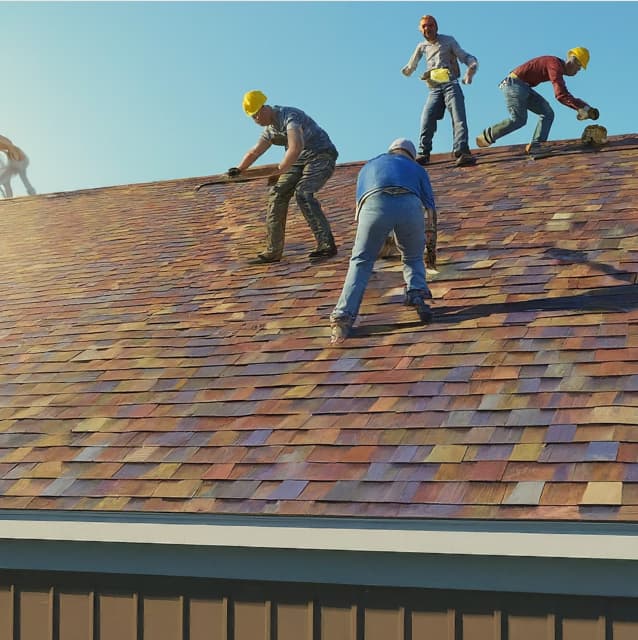Roofing
What Are the Best Roofing Shingles for Your Home?
What Are the Best Roofing Shingles for Your Home? When it comes to protecting and enhancing your home, selecting the right roofing shingles is paramount.
Not only do they shield your dwelling from the elements, but they also contribute significantly to its aesthetic appeal and overall value.
If you find yourself pondering, “What are the best roofing shingles?” you’re not alone. This article aims to guide you through the myriad options to ensure your roof is both durable and visually pleasing.
2. Understanding Roofing Shingles
Roofing shingles are more than just the outermost layer of a home’s roof; they are a critical component that plays a multifaceted role in protecting, insulating, and enhancing the overall aesthetic of a dwelling.
Their primary function is to shield the home from various environmental elements such as rain, snow, hail, and intense sun exposure.
However, the choice of roofing shingles also significantly impacts the architectural appeal and can influence a home’s energy efficiency.
The Role of Roofing Shingles
At their core, roofing shingles serve as the first line of defense against the weather. They are designed to repel water, resist wind, and endure the punishing effects of UV rays and temperature fluctuations.
Beyond their protective role, shingles contribute to the thermal performance of a home by reflecting sunlight and providing insulation, which can help in reducing heating and cooling costs.
Types of Roofing Materials
The market offers a variety of shingle materials, each with its unique properties and aesthetic appeal:
- Asphalt Shingles: The most commonly used roofing material in North America, asphalt shingles are favored for their cost-effectiveness, ease of installation, and wide range of styles and colors. They are made from a fiberglass or organic base coated with asphalt and topped with mineral granules.
- Composite Shingles: These are engineered from synthetic materials to mimic the look of natural wood or stone shingles. Composite shingles are praised for their durability, low maintenance, and resistance to fire and mold.
- Metal Shingles: Metal roofing offers longevity, durability, and energy efficiency. It can be made from steel, aluminum, copper, or zinc, and is available in a variety of finishes that can mimic the look of traditional shingles, tiles, or even wood shakes.
- Slate Shingles: Slate roofing is known for its natural beauty, longevity, and fire resistance. Each slate tile is unique, which lends a distinctive and elegant appearance to homes. However, slate is heavy and requires a strong structural support system.
- Wood Shingles: Wood shingles, typically made from cedar, redwood, or southern pine, offer a natural, rustic look that ages beautifully. They require regular maintenance to prevent decay, mold, and fire hazards.
- Solar Shingles: A modern innovation, solar shingles combine the protective qualities of traditional shingles with the ability to generate electricity. They integrate seamlessly into the roof, preserving the home’s aesthetic while contributing to its energy independence.
Choosing the Right Shingle Material
Selecting the best roofing shingles involves considering various factors such as the climate of the region, the architectural style of the home, personal aesthetic preferences, and budget constraints.
For instance, in areas prone to severe weather conditions, choosing a material known for its resilience, like metal or composite shingles, might be preferable.
On the other hand, in regions with milder climates, the choice might lean towards aesthetic appeal and energy efficiency, making solar or slate shingles a more attractive option.
Moreover, the architectural style of the home plays a significant role in the selection process. Traditional homes might benefit from the classic look of wood or slate shingles, while more modern constructions could embrace the sleek appearance of metal or the innovative features of solar shingles.
3. Key Factors to Consider
Selecting the best roofing shingles for your home involves more than just picking out a color or material you like; it requires thoughtful consideration of several critical factors.
These elements will influence the longevity and performance of your roof, its aesthetic appeal, and your home’s overall energy efficiency.
Here’s a closer look at the key factors you should consider when choosing roofing shingles:
Durability and Lifespan
One of the foremost considerations is how long your roofing shingles will last. Different materials offer varying levels of durability and resistance to environmental factors such as wind, rain, hail, and UV radiation.
For example, metal and slate shingles are known for their exceptional longevity, often lasting 50 years or more, while asphalt shingles typically have a lifespan of 15 to 30 years.
The right choice will depend on your long-term plans for your home and how often you’re willing to replace your roof.
Weather Resistance
The climate in your area plays a significant role in determining the most suitable roofing material. If you live in a region prone to severe weather events like hurricanes, heavy snow, or extreme temperatures, you’ll need shingles to withstand these conditions.
Some materials, like metal shingles, are known for their high wind resistance, while others, such as composite shingles, offer excellent hail resistance.
Aesthetic Appeal
Your roof is a significant part of your home’s curb appeal. The material and color of your shingles should complement the architectural style of your home and blend well with the surrounding environment.
Whether you prefer the rustic charm of wood shingles, the timeless elegance of slate, or the sleek, modern look of metal, the right choice will enhance your home’s visual appeal.
Cost-Effectiveness
Budget is always a consideration in home improvement projects. The cost of roofing shingles can vary widely based on the material, brand, and installation requirements.
While asphalt shingles are generally the most affordable option, investing in more durable materials like metal or slate may offer better long-term value due to their longer lifespans and lower maintenance requirements.
Environmental Impact
Eco-conscious homeowners may also want to consider the environmental impact of their roofing material choice. Solar shingles, for example, not only protect your home but also generate renewable energy, reducing your carbon footprint.
Other materials, like metal shingles, are often made from recycled materials and are fully recyclable at the end of their life, making them a more sustainable choice.
Installation and Maintenance
Some roofing materials require specialized installation techniques and ongoing maintenance to ensure their longevity.
Slate and wood, for example, may require more upkeep and a skilled installer, which can add to the overall cost and effort involved in maintaining your roof.
Consider the level of maintenance you’re willing to commit to and ensure you have access to skilled professionals who can properly install and maintain your chosen material.
4. Types of Roofing Shingles
|
Shingle Type |
Material | Lifespan | Pros |
Cons |
| Asphalt | Fiberglass or Organic | 15-30 years | Affordable, versatile, wide color range | Shorter lifespan, prone to algae/moss |
| Composite | Plastics, Rubber, Asphalt | Up to 50 years | Durable, low maintenance, eco-friendly | Higher cost and quality vary by brand |
| Metal | Steel, Aluminum, Copper, Zinc | 40-70 years | Long-lasting, weather-resistant, energy-efficient | Higher initial cost requires skilled installation |
| Slate | Natural Slate Rock | 100+ years | Extremely durable, fireproof, low maintenance | Expensive, heavy, fragile |
| Solar | Photovoltaic Cells | 20-30 years | Generates electricity, sleek appearance, incentives | High initial cost, lower efficiency than panels, installation complexity |
| Wood | Cedar, Redwood, Pine | 20-30 years | Natural beauty, insulating properties | Requires maintenance, less fire-resistant |
This table summarizes the main types of roofing shingles, their base materials, expected lifespans, advantages, and disadvantages.
It serves as a quick reference guide that readers can use to compare options and narrow down their choices based on their specific needs and preferences.
5. Comparing Top Roofing Shingle Brands
When it comes to selecting the best roofing shingles for your home, the brand you choose plays a pivotal role in ensuring quality, durability, and satisfaction.
The roofing industry is home to several reputable brands, each offering unique benefits and product lines tailored to diverse homeowner needs.
Below, we delve into some of the top roofing shingle brands, highlighting their key features and offerings to help you make an informed decision.
To provide a clearer comparison of these brands, here’s a table summarizing their key attributes:
| Brand | Founded | Notable Products | Warranty | Special Features |
| GAF | 1886 | Timberline® HDZ™, Royal Sovereign® | Limited Lifetime | Advanced Protection®, StainGuard® |
| CertainTeed | 1904 | Landmark® Series, Presidential Shake® | Lifetime limited | ClimateFlex®, NailTrak® |
| Owens Corning | 1938 | Oakridge®, Duration® Series | Limited Lifetime | SureNail®, TruDefinition® Colors |
| IKO | 1951 | Cambridge™, Crowne Slate™ | Limited Lifetime | ArmourZone®, Fastlock™ sealant strips |
6. Cost Analysis
The cost of roofing shingles is a critical factor for most homeowners when considering a roof replacement or installation. It’s important to understand not just the upfront costs, but also the long-term value that different types of roofing materials can provide.
This section will break down the cost considerations associated with various shingle types and offer insights into how you can make a cost-effective decision for your roofing project.
Factors Influencing Shingle Costs
Several elements contribute to the overall cost of roofing shingles, including:
- Material: The type of shingle material is the most significant factor in determining cost. Asphalt shingles are generally the most affordable, while premium materials like slate and metal are at the higher end of the price spectrum.
- Quality and Brand: Within each material category, costs can vary based on the quality of the shingles and the brand. Premium brands often command higher prices due to their reputation for durability and warranty offerings.
- Geographical Location: The cost of roofing materials and labor can vary significantly depending on your location. Areas with higher living costs or those prone to extreme weather conditions might see higher prices.
- Roof Size and Complexity: The larger and more complex your roof is, the more materials and labor will be required, increasing the overall cost.
- Installation: The cost of installation can vary widely among contractors. Some materials, like slate and metal, require specialized installation skills, which can add to the cost.
Average Cost Range by Material
To provide a clearer picture of what you can expect to spend, here’s a breakdown of the average cost range for popular roofing shingle materials, based on a standard 2,000-square-foot roof:
- Asphalt Shingles: $5,000 – $8,000
- Composite Shingles: $7,000 – $12,000
- Metal Shingles: $15,000 – $30,000
- Slate Shingles: $20,000 – $40,000
- Wood Shingles: $10,000 – $20,000
- Solar Shingles: $20,000 – $60,000 (including the cost of solar energy generation capabilities)
These ranges are approximate and can vary based on the factors mentioned earlier.
It’s also worth noting that while some options like solar shingles have a higher upfront cost, they can provide significant energy savings over time, potentially offsetting the initial investment.
Evaluating Long-Term Value
When considering the cost of roofing shingles, it’s crucial to look beyond the initial expense and evaluate the long-term value they offer.
For instance, investing in more durable materials like metal or slate could result in fewer replacements over the lifetime of the roof, ultimately saving money in the long run.
Additionally, some materials may offer energy efficiency benefits, reducing heating and cooling costs and contributing to long-term savings.
Seeking Professional Estimates
To get an accurate understanding of what your roofing project will cost, it’s advisable to seek multiple estimates from reputable contractors.
These professionals can provide detailed quotes that account for the specific requirements of your home, including material, labor, and any additional services like old roof removal and disposal.
7. How to Choose the Best Roofing Shingles for Your Home
Selecting the best roofing shingles for your home is a decision that encompasses various factors, including aesthetics, budget, climate considerations, and long-term maintenance.
This section provides a step-by-step guide to help you navigate through these considerations, ensuring that your choice not only enhances the curb appeal of your home but also offers durability and value.
Assess Your Home’s Architectural Style
The architectural style of your home should guide your choice of roofing shingles. Certain materials complement specific styles better than others. For example:
- Traditional homes might benefit from the classic look of asphalt shingles or the natural beauty of wood shakes.
- Contemporary or modern homes could be well-suited to the sleek, minimalist aesthetic of metal roofing or innovative solar shingles.
- Historic homes may require slate shingles to maintain their authentic appearance and integrity.
Understanding the architectural nuances of your home will help you choose shingles that enhance its character.
Consider Your Climate
The climate you live in plays a significant role in selecting the right roofing material:
- In areas prone to wildfires, fire-resistant materials like metal or slate can offer an added layer of protection.
- For regions that experience heavy snowfall or rain, it’s essential to choose shingles with good water resistance and durability, such as asphalt with a high impact rating or composite shingles.
- In hot, sunny climates, reflective shingles like cool-roof asphalt or metal can help reduce heat absorption and cooling costs.
Evaluate Material Pros and Cons
Each roofing material comes with its own set of advantages and disadvantages. Consider these carefully:
- Asphalt shingles are affordable and easy to install but have a shorter lifespan.
- Metal shingles offer longevity and energy efficiency but come with a higher initial cost.
- Slate is incredibly durable and beautiful but requires sturdy structural support due to its weight.
- Wood shingles provide a natural look but demand regular maintenance to prevent decay and are not as fire-resistant as other materials.
- Solar shingles are eco-friendly and can generate electricity, but the upfront costs are significant.
Determine Your Budget
Your budget will significantly influence your choice of roofing shingles. While it’s tempting to opt for the most economical option, consider the long-term implications of your choice.
More expensive materials like metal or slate may offer better durability and less frequent replacements, potentially saving money in the long run.
Seek Professional Advice
Consulting with a roofing professional can provide valuable insights into the most suitable options for your home.
They can assess your home’s structure, local climate conditions, and personal preferences to recommend the best roofing shingles.
Professionals can also offer information on warranty options, which can add value and peace of mind to your investment.
Making the Final Decision
Once you’ve considered all these factors, you’re in a better position to make an informed decision.
Remember, the best roofing shingles for your home are those that meet your aesthetic preferences, align with your budget, withstand your local climate’s demands, and require a level of maintenance you’re comfortable with.
By taking the time to carefully evaluate your options, you can ensure your new roof will protect and enhance your home for many years to come. [Insert Affiliate Link: Schedule a Consultation with a Roofing Expert]
8. Installation and Maintenance
The longevity and performance of your roofing shingles are heavily influenced by the quality of the installation and the commitment to ongoing maintenance.
Understanding the essentials of both can help you ensure that your chosen roofing material provides the best protection for your home over its intended lifespan.
Installation Essentials
The installation process varies significantly between different types of roofing materials, and it’s crucial to adhere to best practices specific to the material you choose:
- Contractor Selection: Always hire a reputable and experienced roofing contractor who specializes in your chosen material. Verify their credentials, ask for references, and check reviews.
- Underlayment and Ventilation: A proper underlayment is essential for waterproofing, while adequate ventilation helps regulate attic temperatures and moisture levels, prolonging the life of your shingles.
- Sealing and Flashing: Ensure that all seals and flashing are correctly installed around roof penetrations, such as chimneys and vent pipes, to prevent water damage.
- Manufacturer’s Guidelines: Following the manufacturer’s installation guidelines is critical. Incorrect installation can void warranties and compromise the roof’s durability.
Maintenance Considerations
Regular maintenance can significantly extend the life of your roof, regardless of the material:
- Regular Inspections: Conduct (or hire a professional to perform) bi-annual inspections of your roof to identify and address potential issues early, such as lifting shingles, damaged flashing, or blocked gutters.
- Debris Removal: Keep your roof clear of debris, such as leaves and branches, which can retain moisture and lead to mold, mildew, and eventual material degradation.
- Moss and Algae Treatment: In damp climates, moss, and algae can be a problem for many roofing materials, particularly wood and asphalt. There are treatments and cleaning methods to manage these growths without damaging the shingles.
- Immediate Repairs: Addressing small issues promptly can prevent more significant, costly problems down the line. This includes replacing missing or damaged shingles and sealing minor leaks.
- Professional Maintenance: For some materials, like slate or metal, it might be beneficial to have a professional roofing contractor conduct periodic maintenance checks to ensure everything is in optimal condition.
Special Considerations by Material
- Asphalt Shingles: Look out for granule loss, curling, or cracking, which are signs of aging or exposure damage.
- Metal Shingles: Monitor for scratches, dents, or rust, and ensure that fasteners remain tight and sealed.
- Slate Tiles: These require minimal maintenance but can crack or become dislodged. They should be inspected and repaired by specialists due to their fragility.
- Wood Shingles: Regular treatment to prevent rot, mold, and insect infestation is crucial, along with cleaning to remove moss or algae buildup.
- Solar Shingles: Beyond standard roofing maintenance, ensure the photovoltaic components are functioning correctly and efficiently, with regular checks by a solar specialist.
9. Conclusion
Selecting the best roofing shingles for your home is a significant decision that influences both its protection and aesthetic appeal.
By considering the types, brands, and costs, and seeking professional advice, you can make an informed choice that meets your needs and enhances your home for years to come.
Recent Posts
- Rubber Roof Repair – A Comprehensive Guide
- Shingle Roof Repair: A Comprehensive Guide for Homeowners
- How to Repair RV Roof: The Ultimate Guide
- Metal Roof Repair: Ultimate Guide to Resilient Solutions




